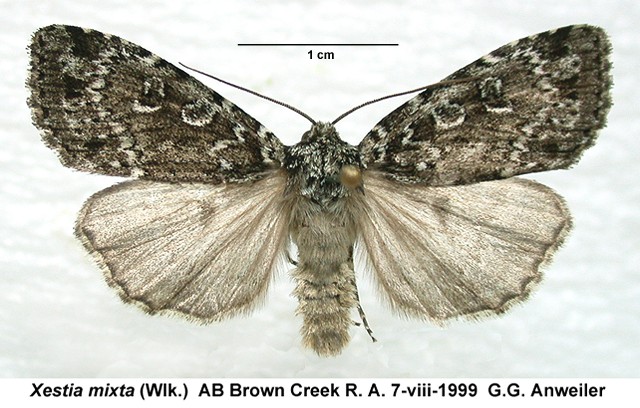Species Details
Xestia mixta
University of Alberta E.H. Strickland Entomological Museum Read more about this collection »
Seasonalityadults from mid July through mid August
IdentificationA medium-size (approximately 3.5-4.0 cm wingspan) moth with grey-black forewings and pale grey hindwings. The forewings are crossed with narrow, contrasting white "sawtoothed" basal, antemedian and postmedian lines. The reniform and orbicular spots are white, but filled or almost filled with dark scales and appearing as white rings. The subterminal and terminal lines are indicated by black scales forming small spots, and the fringe is lightly checkered, The hindwings are light grey, faintly banded and with a darker grey discal mark and narrow dark terminal line. Sexes similar and antennae simple. Very similar to but usually smaller than X. speciosa, which is usually lighter grey, not blackish, and has less contrasting white lines. There are also differences in the genitalia of both sexes (see Lafontaine 1998 for descriptions and images). In the mountains it is difficult to separate from dark forms of speciosa; in the boreal region it is most like X. perquiritata, which lacks the dark scales filling most of the reniform spot.
Scientific Name
Xestia mixta
Habitat
open coniferous woodlands and boggy areas.
Seasonality
adults from mid July through mid August
Identification
A medium-size (approximately 3.5-4.0 cm wingspan) moth with grey-black forewings and pale grey hindwings. The forewings are crossed with narrow, contrasting white "sawtoothed" basal, antemedian and postmedian lines.…
A medium-size (approximately 3.5-4.0 cm wingspan) moth with grey-black forewings and pale grey hindwings. The forewings are crossed with narrow, contrasting white "sawtoothed" basal, antemedian and postmedian lines. The reniform and orbicular spots are white, but filled or almost filled with dark scales and appearing as white rings. The subterminal and terminal lines are indicated by black scales forming small spots, and the fringe is lightly checkered, The hindwings are light grey, faintly banded and with a darker grey discal mark and narrow dark terminal line. Sexes similar and antennae simple. Very similar to but usually smaller than X. speciosa, which is usually lighter grey, not blackish, and has less contrasting white lines. There are also differences in the genitalia of both sexes (see Lafontaine 1998 for descriptions and images). In the mountains it is difficult to separate from dark forms of speciosa; in the boreal region it is most like X. perquiritata, which lacks the dark scales filling most of the reniform spot.
Life History
Adults are nocturnal and come to light. There is a single annual brood, with adults from mid July through mid August. The larva is described by Lafontaine (1998), and has been reared in the lab on blueberry (Vaccinium…
Adults are nocturnal and come to light. There is a single annual brood, with adults from mid July through mid August. The larva is described by Lafontaine (1998), and has been reared in the lab on blueberry (Vaccinium myrtilloides Michx.) (Ericaceae).
Diet Info
The larva have been reared in the lab on blueberries (Vaccinium myrtilloides Michx.)
Range
This is a boreal species, found from NFLD west to the Alberta foothills, north to the southern NWT and south to southern AB. It is found in open coniferous woodlands and boggy areas.
References
Author
Lafontaine, J. Donald
Title
Noctuoidea : Noctuidae (part-Noctuini)
Publication Date
1998
Pages
348
Specimen Information
There are 64 specimens of this Species.
CBCC1461 - Xestia mixta
University of Alberta E.H. Strickland Entomological Museum
Place CollectedCanada: Alberta, Moose Lake Provincial Park
Collected ByChristensen, C. B.
Date Collected2005-07-21
